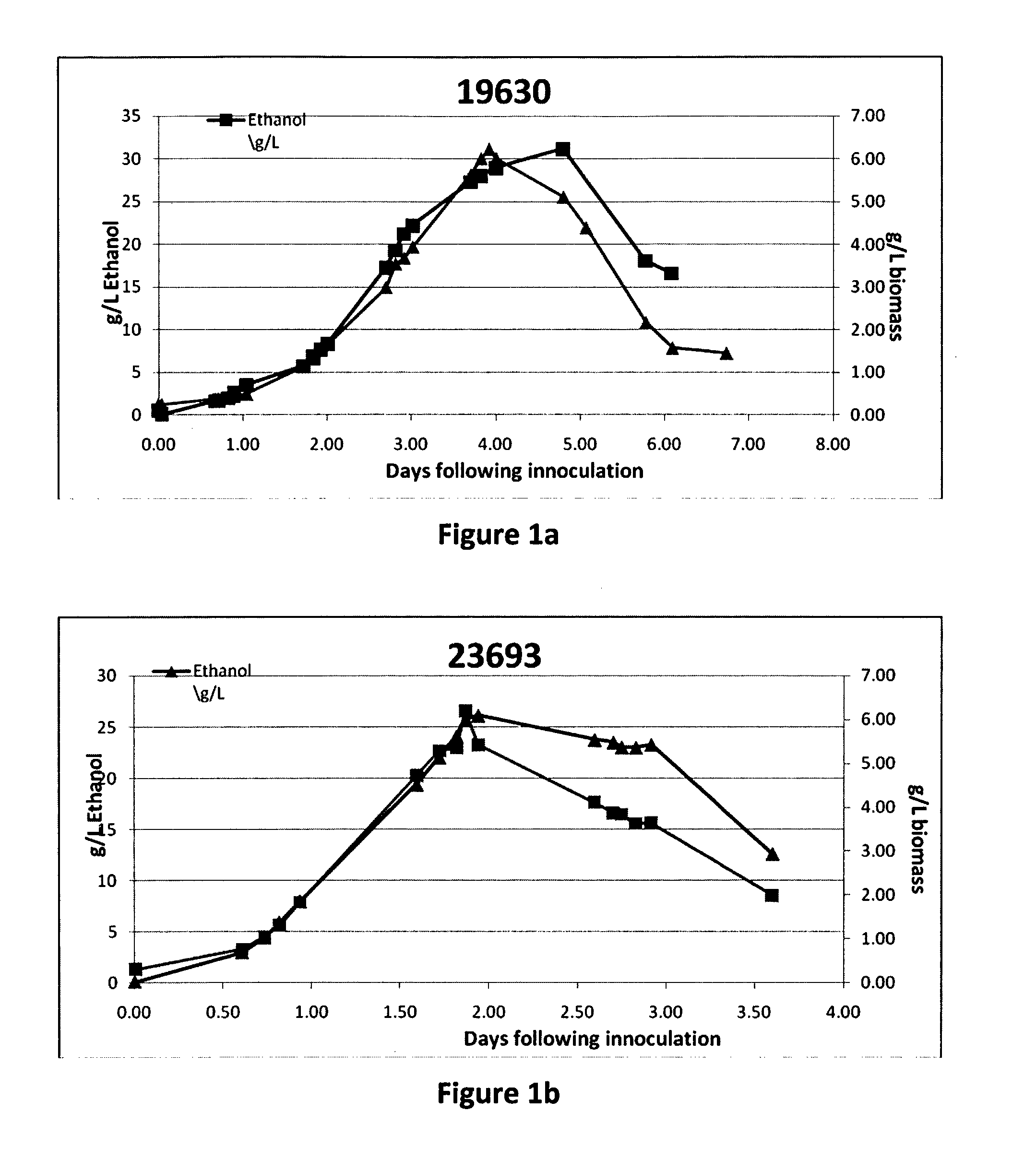Process for producing ethanol and ethylene via fermentation
a technology of ethanol and ethylene, which is applied in the field of process for producing ethanol and ethylene via fermentation, can solve the problems of increasing the cost of industrial plants, releasing co into the atmosphere, and having significant environmental impa
- Summary
- Abstract
- Description
- Claims
- Application Information
AI Technical Summary
Benefits of technology
Problems solved by technology
Method used
Image
Examples
example 1
[0105]Materials and Methods:
Solution ANH4Ac3.083 gKCl0.15 gMgCl2•6H2O 0.4 gNaCl (optional)0.12 gCaCl2•2H2O0.294 gDistilled WaterUp to 1 LSolution BBiotin 20.0 mgCalcium D-(*)-50.0 mgpantothenateFolic acid 20.0 mgVitamin B1250.0 mgPyridoxine•HCl 10.0 mgp-Aminobenzoic50.0 mgacidThiamine•HCl 50.0 mgThioctic acid50.0 mgRiboflavin 50.0 mgDistilled waterTo 1 LitreNicotinic acid 50.0 mgComponentmmol / L H2OComponentmmol / L H2OSolution CFeCl30.1Na2SeO30.01CoCl20.05Na2MoO40.01NiCl20.05ZnCl20.01H3BO30.01MnCl20.01Na2WO30.01
[0106]Preparation of Cr (II) solution: A 1 L three necked flask was fitted with a gas tight inlet and outlet to allow working under inert gas and subsequent transfer of the desired product into a suitable storage flask. The flask was charged with CrCl3.6H2O (40 g, 0.15 mol), zinc granules [20 mesh] (18.3 g, 0.28 mol), mercury (13.55 g, 1 mL, 0.0676 mol) and 500 mL of distilled water. Following flushing with N2 for one hour, the mixture was warmed to about 80° C. to initiate the...
example 2
[0119]Materials and Methods:
[0120]Bacterial strains and growth conditions: C. autoethanogenum DSM 10061 and C. ljungdahlii DSM 13582 were obtained from DSMZ (Deutsche Sammlung von Mikroorganismen and Zellkulturen GmbH) and C. ragsdalei ATCC-BAA 622TM from ATCC (American Type Culture Collection). All organisms were cultivated anaerobically in modified PETC medium (ATCC medium 1754) at 30° C. (C. ragsdalei) or respectively 37° C. (C. autoethanogenum and C. ljungdahlii).
[0121]The modified PETC medium contained (per L) 1 g NH4Cl, 0.4 g KCl, 0.2 g MgSO4×7 H2O, 0.8 g NaCl, 0.1 g KH2PO4, 20 mg CaCl2×2 H2O, 10 ml trace elements solution (see below), 10 ml Wolfe's vitamin solution (see below), 2 g NaHCO3, and 1 mg resazurin. After the pH was adjusted to 5.6, the medium was boiled, dispensed anaerobically, and autoclaved at 121° C. for 15 min. Steel mill waste gas (composition: 44% CO, 32% N2, 22% CO2, 2% H2) collected from a New Zealand steel site in Glenbrook, NZ or 0.5% (w / v) fructose (wit...
PUM
| Property | Measurement | Unit |
|---|---|---|
| concentration | aaaaa | aaaaa |
| pressure | aaaaa | aaaaa |
| pressure | aaaaa | aaaaa |
Abstract
Description
Claims
Application Information
 Login to View More
Login to View More - R&D
- Intellectual Property
- Life Sciences
- Materials
- Tech Scout
- Unparalleled Data Quality
- Higher Quality Content
- 60% Fewer Hallucinations
Browse by: Latest US Patents, China's latest patents, Technical Efficacy Thesaurus, Application Domain, Technology Topic, Popular Technical Reports.
© 2025 PatSnap. All rights reserved.Legal|Privacy policy|Modern Slavery Act Transparency Statement|Sitemap|About US| Contact US: help@patsnap.com



